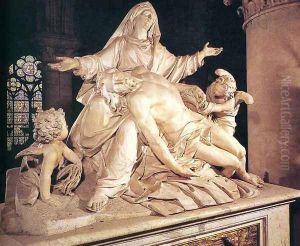Nicolas Coustou Paintings
Nicolas Coustou was a French sculptor born on January 9, 1658, in Lyon, France, into a family of artists. His father, Paul Coustou, was a woodcarver, and his uncle, Antoine Coysevox, was a prominent sculptor who greatly influenced Nicolas's career. Nicolas moved to Paris to train under his uncle after initially studying in Lyon. He further honed his skills at the French Academy in Rome, where he was a resident at the Villa Medici after winning the prestigious Prix de Rome in 1682 for his bas-relief 'The Hunt of Meleager,' which depicted a scene from Greek mythology.
After returning to France in 1686, Coustou began working on a series of notable commissions that would establish his reputation. His style, while classical, incorporated a sense of movement and emotional expression that reflected the Baroque sensibilities of the time. One of his most significant early works was a marble statue of Julius Caesar, completed in 1696 for the Gardens of Versailles. In 1700, he became a professor at the Royal Academy of Painting and Sculpture, and in 1715, he was appointed rector of the institution.
Nicolas Coustou's most famous works include the 'Descent from the Cross' for the Notre Dame Cathedral in Paris, completed in 1714, and the 'Marly Horses,' also known as 'The Horse Tamers,' created with his brother, Guillaume Coustou, for the Château de Marly. These sculptures were later moved to the Champs-Élysées in Paris. Nicolas's body of work is characterized by its dynamic forms and the emotional intensity of its figures.
Throughout his career, Coustou remained influential and received numerous commissions from the royal court and religious institutions. His works can be found in various locations across France, including Versailles, the Louvre, and other public spaces. Nicolas Coustou's contributions to French sculpture helped to perpetuate the classical tradition while also incorporating the evolving artistic trends of his time. He passed away on May 1, 1733, in Paris, leaving behind a legacy that would continue to be celebrated for its artistic merit and historical significance.
